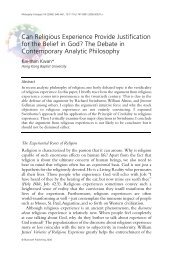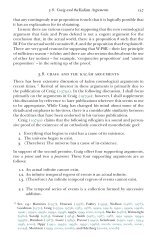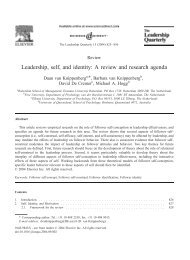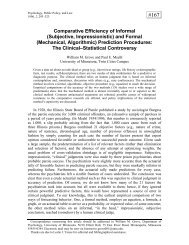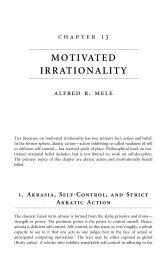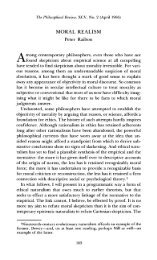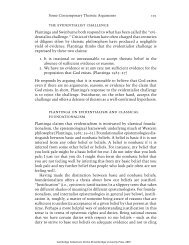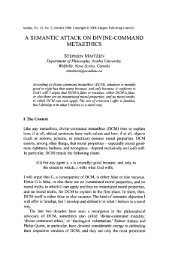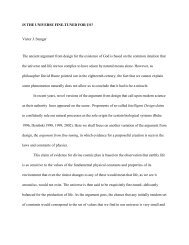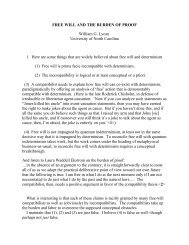Atheism and Theism JJ Haldane - Common Sense Atheism
Atheism and Theism JJ Haldane - Common Sense Atheism
Atheism and Theism JJ Haldane - Common Sense Atheism
Create successful ePaper yourself
Turn your PDF publications into a flip-book with our unique Google optimized e-Paper software.
<strong>Atheism</strong> <strong>and</strong> <strong>Theism</strong> 89<br />
seems natural to say that these parts <strong>and</strong> functions exist for the well-being of<br />
the animals, be they individuals or species, <strong>and</strong>, assuming that they are not<br />
intelligent entities prudently directing their own behaviour, that the existence<br />
of such well-organized structures points to a benign designer.<br />
This, in essence, is the last of Aquinas’s famous five ways (quinque viae) or<br />
proofs set out in response to the second question ‘whether there is a God’ of<br />
the Summa Theologiae (Ia, q. 2, a. 3.). The text is brief <strong>and</strong> worth quoting in<br />
full to give a flavour of the directness of Aquinas’s style:<br />
The fifth way is based on the guidedness of nature. Goal-directed behaviour<br />
is observed in all bodies in nature, even those lacking awareness; for we see<br />
their behaviour hardly ever varying <strong>and</strong> practically always turning out well,<br />
which shows they truly tend to goals <strong>and</strong> do not merely hit them by accident.<br />
But nothing lacking awareness can tend to a goal except it be directed by<br />
someone with awareness <strong>and</strong> underst<strong>and</strong>ing; arrows by archers, for example. So<br />
everything in nature is directed to its goal by someone with underst<strong>and</strong>ing <strong>and</strong><br />
this we call God. 8<br />
St Thomas’s formulation can be applied to the issue of fine tuning but at<br />
this stage I am concerned with apparent purpose in the organization <strong>and</strong><br />
activity of living things. Belief in real teleology <strong>and</strong> in the need of a purposeful<br />
agent to create <strong>and</strong> sustain it has been held to be refuted on the basis<br />
of the theory of natural selection. Given replication, inheritance, variation,<br />
environment <strong>and</strong> time the range of animate species is explicable in physicomechanical<br />
terms. So it is said, but the issue is not quite so clear.<br />
First, a concession to the anti-teleologist or mechanist. It is right for him<br />
or her to argue that the traditional design argument is challenged by the mere<br />
possibility of evolutionary explanations. If the existence of such complex<br />
animals could be the result of natural mechanico-evolutionary processes, then<br />
any argument to the effect that they could only have come into existence<br />
through a special creation is thereby refuted. This is correct, but note where<br />
the concession leaves the debate. Unless the evolutionist has an argument<br />
to show that creation is excluded we are faced with competing hypotheses.<br />
Indeed the dialectic is subtler still, since the theist may not want to exclude<br />
evolutionary theory as an account of the history of species development but<br />
only to reject it as a complete explanation. However, even this position requires<br />
that he or she produce reasons for thinking that natural selection cannot be<br />
the whole story.<br />
I think there are three places, or points of transition, at which such reasons<br />
may be found. First, the step from non-living to living entities; second, the<br />
step from basic ‘life forms’ to reproductive species; <strong>and</strong> third, the transition from<br />
mindless to minded life. I shall deal with the last of these later <strong>and</strong> at some<br />
length but take the first <strong>and</strong> second together now.



